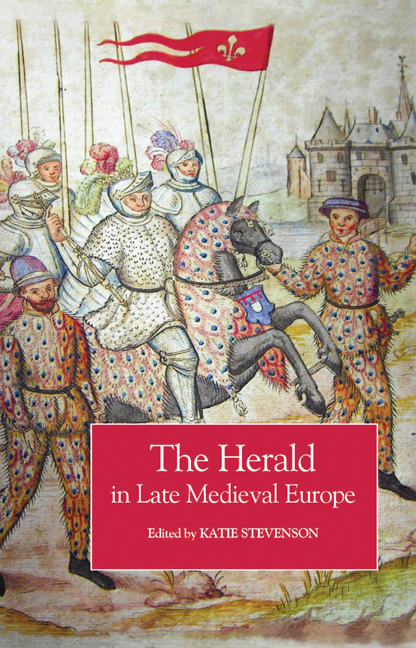Book contents
- Frontmatter
- Contents
- List of Illustrations
- Notes on Contributors
- Acknowledgements
- Abbreviations
- 1 Introduction
- 2 The Development of the Office of Arms in England, c. 1413–1485
- 3 Ancient Precedent or Tudor Fiction? Garter King of Arms and the Pronouncements of Thomas, Duke of Clarence
- 4 Jurisdiction, Authority and Professionalisation: The Officers of Arms of Late Medieval Scotland
- 5 The March of Brittany and its Heralds in the Later Middle Ages
- 6 City Heralds in the Burgundian Low Countries
- 7 King of Arms of the Ruwieren: A Special Function in the German Empire
- 8 Heraldry, Heralds and Politics in the Republic of Florence in the Late Middle Ages
- 9 Tournaments, Heraldry and Heralds in the Kingdom of Poland in the Late Middle Ages
- 10 A time when ‘fools and dwarfs were highly esteemed’? Seeking the Late Medieval Scandinavian Herald
- Index
3 - Ancient Precedent or Tudor Fiction? Garter King of Arms and the Pronouncements of Thomas, Duke of Clarence
Published online by Cambridge University Press: 26 October 2017
- Frontmatter
- Contents
- List of Illustrations
- Notes on Contributors
- Acknowledgements
- Abbreviations
- 1 Introduction
- 2 The Development of the Office of Arms in England, c. 1413–1485
- 3 Ancient Precedent or Tudor Fiction? Garter King of Arms and the Pronouncements of Thomas, Duke of Clarence
- 4 Jurisdiction, Authority and Professionalisation: The Officers of Arms of Late Medieval Scotland
- 5 The March of Brittany and its Heralds in the Later Middle Ages
- 6 City Heralds in the Burgundian Low Countries
- 7 King of Arms of the Ruwieren: A Special Function in the German Empire
- 8 Heraldry, Heralds and Politics in the Republic of Florence in the Late Middle Ages
- 9 Tournaments, Heraldry and Heralds in the Kingdom of Poland in the Late Middle Ages
- 10 A time when ‘fools and dwarfs were highly esteemed’? Seeking the Late Medieval Scandinavian Herald
- Index
Summary
IN 1530 GARTER KING OF ARMS AND CLARENCEUX KING OF ARMS, the two most senior heralds in England and Wales, were embroiled in a bitter controversy. The dispute had been sparked off by a commission granted by Henry VIII (1509–47) to Thomas Benolt, Clarenceux King of Arms (from 1511 to 1534), allowing him to go on visitation in his southern province (England south of the Tees) and forbidding interference in this task by any other herald. The purpose of such a visit was to register the arms and pedigrees of the nobility and gentry and, if necessary, reform heraldic abuses and grant new arms. Sir Thomas Wriothesley, Garter King of Arms (from 1505 to 1534), was indignant, believing that he too should be allowed to go on visitation and grant arms to whomsoever he pleased. As Garter King of Arms ‘of the English’ he believed his heraldic jurisdiction covered the whole country; technically he did not have a specific geographical province. To substantiate his arguments, Garter King of Arms constantly referred to documents that he claimed dated to the reign of Henry V (1413–22). In particular he quoted from several pronouncements reputedly issued between 1417 and 1421 by no less a person than Thomas, duke of Clarence and brother of the victor of Agincourt. But to what extent were these documents genuine and, if they were not, who did produce them and how old were they? Did they, in fact, owe more to Thomas Wriothesley, Garter King of Arms, than they did to Thomas, duke of Clarence?
Henry V's reign was clearly influential in the development of heralds and heraldry in England. This may have been prompted in part by the establishment of the French royal heralds in 1407 as a corporate body with their own home in Paris. On 22 April 1415, just before indentures of military service were entered into for his Agincourt campaign, Henry issued the earliest known statutes of the Order of the Garter. Some time between 22 May and 3 September 1417 he appointed William Bruges as the first Garter King of Arms. This may have taken place before late July when Henry, and very probably Bruges, set sail for his second invasion of France.
- Type
- Chapter
- Information
- The Herald in Late Medieval Europe , pp. 29 - 40Publisher: Boydell & BrewerPrint publication year: 2009

